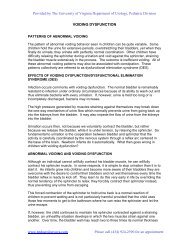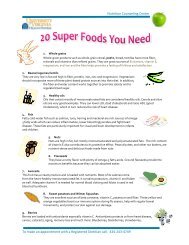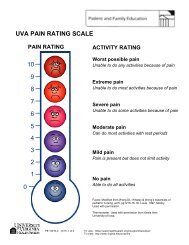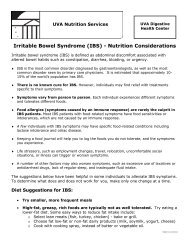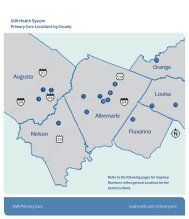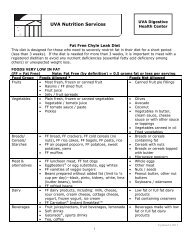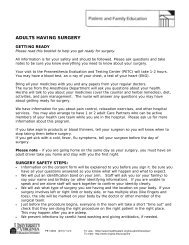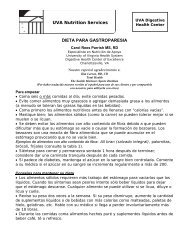Safety tips for children in the hospital
Safety tips for children in the hospital
Safety tips for children in the hospital
Create successful ePaper yourself
Turn your PDF publications into a flip-book with our unique Google optimized e-Paper software.
SAFETY TIPS FOR THE HOSPITALIZED CHILD<br />
UVA CHILDREN’S HOSPITAL<br />
PATIENT AND FAMILY EDUCATION<br />
People go to <strong>the</strong> <strong>hospital</strong> <strong>for</strong> surgeries, procedures, and treatments. While your child is <strong>in</strong> <strong>the</strong> <strong>hospital</strong>, busy<br />
caregivers can use your help. Work toge<strong>the</strong>r with caregivers to create <strong>the</strong> best place <strong>for</strong> your child by<br />
mak<strong>in</strong>g it a safe place. Patient safety helps prevent <strong>in</strong>jury, errors, and <strong>the</strong> spread of germs. Practice patient<br />
safety by us<strong>in</strong>g <strong>the</strong> <strong>tips</strong> listed below. The follow<strong>in</strong>g are some th<strong>in</strong>gs you can do to assure a safe <strong>hospital</strong><br />
stay <strong>for</strong> your child:<br />
• Ask health care providers to identify <strong>the</strong>mselves and expla<strong>in</strong> what <strong>the</strong>y are do<strong>in</strong>g and be sure <strong>the</strong>y<br />
correctly look at your child’s identification bracelet.<br />
• Be sure <strong>the</strong>y have all <strong>the</strong> important health <strong>in</strong><strong>for</strong>mation about your child.<br />
• Be sure all of those with direct contact with you have washed <strong>the</strong>ir hands.<br />
• Ask about anyth<strong>in</strong>g and everyth<strong>in</strong>g you don’t understand.<br />
• Speak up if you have questions or concerns.<br />
• If you are leav<strong>in</strong>g your room let your nurs<strong>in</strong>g staff know and wear shoes or safety skid slippers.<br />
• Use <strong>the</strong> call light if you need help.<br />
CONTROL THE SPREAD OF GERMS<br />
• Good hand wash<strong>in</strong>g will prevent spread<strong>in</strong>g germs that may cause <strong>in</strong>fection or make your child’s<br />
condition worse. Wash hands with soap and water or use <strong>the</strong> hand sanitizer gel frequently especially<br />
after your child has gone to <strong>the</strong> potty, after diaper changes, and be<strong>for</strong>e eat<strong>in</strong>g. Rem<strong>in</strong>d caregivers to<br />
wash <strong>the</strong>ir hands or wear gloves when car<strong>in</strong>g <strong>for</strong> your child.<br />
• Do not allow friends and relatives with colds or o<strong>the</strong>r <strong>in</strong>fections to visit. Your child may be on<br />
"isolation precautions". These are rules that must be followed to stop disease from spread<strong>in</strong>g to or from<br />
your child. For example, everyone may have to wear gloves, masks, and gowns around your child.<br />
• Ask if your child should be vacc<strong>in</strong>ated. If your child has diabetes, heart, lung, kidney or o<strong>the</strong>r major<br />
organ problems, ask about vacc<strong>in</strong>es (shots). Your child's caregiver may want to give your child a flu or<br />
pneumonia vacc<strong>in</strong>e to help fight those <strong>in</strong>fections.<br />
• Let caregivers know if your child's bedd<strong>in</strong>g, gown, or o<strong>the</strong>r l<strong>in</strong>ens are dirty. They will change <strong>the</strong> bed<br />
or give your child a clean gown or towel. Wash toys, pacifiers, or bottles that drop to <strong>the</strong> floor. Wash<br />
plastic or rubber items us<strong>in</strong>g hot water and soap <strong>in</strong> <strong>the</strong> s<strong>in</strong>k. Take stuffed animals or objects made of<br />
cloth home to wash.<br />
PREVENT FALLING<br />
• Let your child’s nurse know if you th<strong>in</strong>k your child is at risk <strong>for</strong> fall<strong>in</strong>g. They will place a special p<strong>in</strong>k<br />
identification bracelet on your child to alert caregivers and help make sure your child does not fall.<br />
• Provide safe cloth<strong>in</strong>g. Your child should wear slippers with rubber soles and pajamas that do not drag<br />
on <strong>the</strong> ground. This way, your child will not slip or trip while out of bed. Your caregiver can provide<br />
gowns and slippers <strong>for</strong> your child.<br />
• All <strong>children</strong> under age 3 years will be placed <strong>in</strong> a crib with side rails up <strong>for</strong> safety reasons. Side rails<br />
must be up if your child is <strong>in</strong> bed. Infants and small <strong>children</strong> can roll out of bed quickly, even when<br />
you are watch<strong>in</strong>g <strong>the</strong>m closely. If you have an <strong>in</strong>fant <strong>in</strong> an <strong>in</strong>cubator, always shut sides and portholes<br />
(doors) tightly be<strong>for</strong>e walk<strong>in</strong>g away from <strong>the</strong> bedside.<br />
Adapted from Micromedex Care Notes 1 of 2<br />
PE# 12006 (6/07) To order: http://www.virg<strong>in</strong>ia.edu
• Tell your child to always ask <strong>for</strong> help when gett<strong>in</strong>g out of bed. Try<strong>in</strong>g to get out of bed without help is<br />
<strong>the</strong> most common cause of falls <strong>in</strong> <strong>the</strong> <strong>hospital</strong>. If you are not <strong>the</strong>re to help your child out of bed, show<br />
your child how and when to use <strong>the</strong> call button. This will call a caregiver to come help. Make sure <strong>the</strong><br />
bed is at a low enough level <strong>for</strong> your child to get out of bed com<strong>for</strong>tably. Ask a caregiver to lower <strong>the</strong><br />
bed if it is too high.<br />
• Keep a clear path <strong>for</strong> your child. Use enough overhead light<strong>in</strong>g to make it easy <strong>for</strong> your child to see<br />
while mov<strong>in</strong>g around <strong>the</strong> room.<br />
• Please be sure to br<strong>in</strong>g any special items such as eye glasses, hear<strong>in</strong>g aids, wheel chair, Feed<strong>in</strong>g<br />
tubes/extensions, and car seats.<br />
• If your child wears glasses, please br<strong>in</strong>g <strong>the</strong>m.<br />
• Always stay close to help your child while walk<strong>in</strong>g with an IV pole or o<strong>the</strong>r equipment or if weak or<br />
sleepy.<br />
TALK TO YOUR CHILD'S CAREGIVERS<br />
• If you have any questions about your child's health problems or care, ask a caregiver. If a caregiver is<br />
not available, write down your questions so you will not <strong>for</strong>get <strong>the</strong>m.<br />
• Ask <strong>for</strong> an <strong>in</strong>terpreter if you do not speak or understand English very well or if you or your child are<br />
deaf.<br />
• Always tell caregivers if your child is allergic to any drugs or foods, or has any o<strong>the</strong>r types of allergies.<br />
• You will receive written discharge <strong>in</strong>structions and medication <strong>in</strong>struction sheets to take home with<br />
you. This way you will have phone numbers and home care and medication <strong>in</strong>structions written down<br />
<strong>in</strong> case you <strong>for</strong>get <strong>the</strong>m. Please br<strong>in</strong>g your discharge <strong>in</strong>structions with you to your follow up<br />
appo<strong>in</strong>tments.<br />
• We encourage family centered care. We encourage you to stay with your child. Please let us know<br />
when you leave and how to contact you.<br />
DECREASE THE CHANCE OF MEDICATION ERRORS<br />
• Your child must wear an identification (ID) band at all times.<br />
• Learn about your child's medications. Know when and why <strong>the</strong>y must taken <strong>the</strong>m, and learn how and<br />
when to give <strong>the</strong>m. If a caregiver has a medic<strong>in</strong>e that you do not know about, ask about it be<strong>for</strong>e it is<br />
given.<br />
• Do not give your child medic<strong>in</strong>es without first ask<strong>in</strong>g your child's nurse. These <strong>in</strong>clude outpatient<br />
prescriptions, over-<strong>the</strong>-counter drugs, vitam<strong>in</strong>s, herbs, or food supplements. Do not br<strong>in</strong>g <strong>in</strong><br />
medications from home unless your child’s caregiver asks you to.<br />
• Tell your child's caregivers if you th<strong>in</strong>k a medic<strong>in</strong>e is not help<strong>in</strong>g or is caus<strong>in</strong>g side effects. Tell<br />
caregivers right away if you th<strong>in</strong>k your child is hav<strong>in</strong>g an allergic reaction to a medic<strong>in</strong>e.<br />
KNOW ABOUT YOUR CHILD'S TREATMENTS AND EQUIPMENT<br />
• Make sure bed and wheelchair wheels are locked while transferr<strong>in</strong>g your child <strong>in</strong> or out.<br />
• Know about <strong>the</strong> equipment attached to your child. Ask about equipment alarms and what you should<br />
do if <strong>the</strong> alarm sounds.<br />
• Learn about any treatments your child will receive while <strong>in</strong> <strong>the</strong> <strong>hospital</strong>. Ask why <strong>the</strong> treatment is<br />
be<strong>in</strong>g given, how you can help, and what to expect after it is over. Tell caregivers if your child's tubes<br />
or dress<strong>in</strong>gs become loose or wet. Caregivers will check if IVs, ca<strong>the</strong>ters, or o<strong>the</strong>r tubes are still <strong>in</strong> <strong>the</strong><br />
right place.<br />
• For more <strong>in</strong><strong>for</strong>mation about patient safety <strong>in</strong> <strong>the</strong> <strong>hospital</strong>, you may contact <strong>the</strong> follow<strong>in</strong>g<br />
foundation: National Patient <strong>Safety</strong> Foundation, 515 N. State Street, Chicago, Ill<strong>in</strong>ois 60610,<br />
Phone: 1-312-464-4848, www.npsf.org<br />
2 of 2





